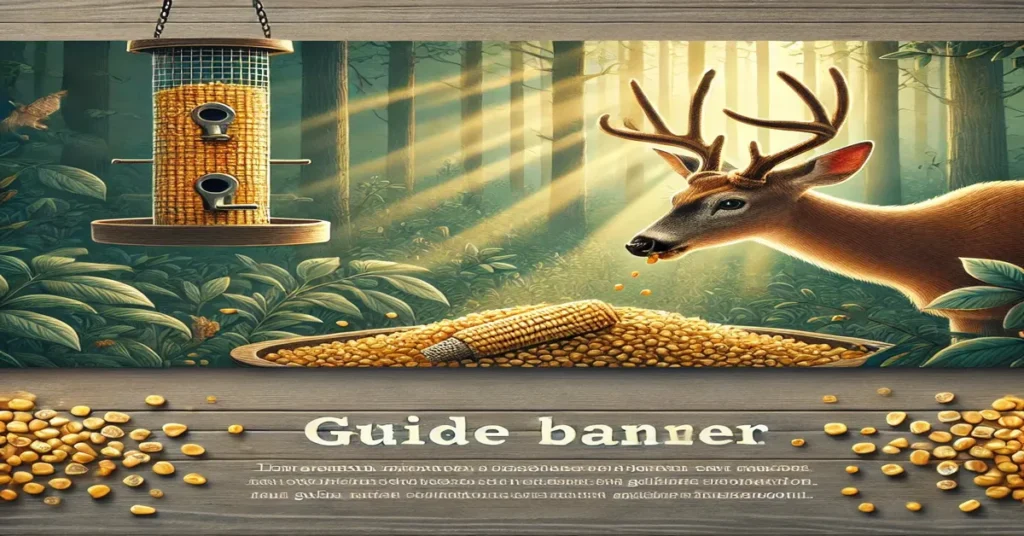Deer corn is a widely recognized and extensively used product among hunters, wildlife enthusiasts, and conservationists. Its primary purpose is to attract and feed deer, but its applications and benefits extend beyond this simple role. In this article, we’ll explore everything you need to know about deer corn: what it is, its nutritional benefits, its role in wildlife management, how to use it effectively, potential concerns, and much more.
What is Deer Corn?
Deer corn refers to dried whole-kernel corn marketed specifically for feeding deer and other wildlife. It is a common staple in areas where wildlife feeding is a popular activity. Typically sold in bags ranging from 25 to 50 pounds, deer corn is affordable, readily available, and easy to use.
Deer corn is appreciated for its high energy content, simplicity, and effectiveness in attracting deer. It is also versatile, as it can be used as a supplemental feed, bait for hunting, or a means of observing wildlife behavior.
Nutritional Profile of Deer Corn
Corn is a carbohydrate-rich feed that provides energy to deer, especially during periods when natural forage is limited. However, it is important to note that corn is not a complete source of nutrition. Below is a breakdown of its key nutritional elements:
- Carbohydrates: Corn contains a high percentage of carbohydrates, making it an excellent energy source for deer.
- Protein: While corn has protein, the levels are relatively low (about 7-9%). This means it cannot support muscle development or antler growth without supplementary protein sources.
- Fats: Corn provides minimal fat content but enough to offer some energy for wildlife.
- Vitamins and Minerals: Corn lacks many essential vitamins and minerals, such as calcium and phosphorus, which are crucial for bone and antler development.
Why Use Deer Corn?
1. Attracting Deer for Observation or Photography
Deer corn is one of the most effective tools for attracting deer to a specific area. Wildlife photographers and nature enthusiasts often use corn to bring deer closer for observation or photography.
2. Hunting Preparation
For hunters, deer corns serves as bait to attract deer during hunting seasons. Many states regulate the use of bait for hunting, so it is crucial to follow local laws and ethical practices.
3. Supplemental Feeding
In winter or during droughts, natural forage may become scarce. Feeding deer with corn can help sustain them during these periods. It is important to combine corn with other feeds to ensure the animals receive a balanced diet.
4. Wildlife Conservation
Feeding programs that incorporate deer corns can help manage wildlife populations, especially in areas where deer densities are high. These programs can prevent starvation, reduce disease transmission, and promote healthier ecosystems.
How to Use Deer Corn Effectively
1. Choosing the Right Location
Select a safe and accessible area for feeding. Avoid locations near roads, as they may increase the risk of deer-vehicle collisions.
2. Timing
Deer are crepuscular, meaning they are most active during dawn and dusk. Distribute the corn during these periods to maximize its effectiveness.
3. Using Feeders
There are several types of feeders available, including gravity-fed, timed-release, and homemade feeders. Each type has its advantages:
- Gravity-fed feeders: Simple and reliable.
- Timed-release feeders: Dispense corn at set intervals to prevent overfeeding.
- Homemade feeders: Cost-effective and customizable.
4. Blending with Other Feeds
To provide a more balanced diet, mix deer corns with other feeds such as protein pellets, alfalfa, or forage blocks.
5. Monitoring Consumption
Overfeeding can lead to waste and attract non-target species such as raccoons, squirrels, and feral hogs. Monitor feeding sites to adjust the amount as needed.
Considerations and Potential Drawbacks
1. Nutritional Imbalance
While deer corns is high in energy, it lacks the nutrients necessary for long-term health. Prolonged reliance on corn can lead to malnutrition and other health issues.
2. Overcrowding
Feeding sites can attract large numbers of deer, increasing the risk of disease transmission. Chronic wasting disease (CWD), for example, spreads more easily in crowded conditions.
3. Legal Regulations
Many states and countries have specific laws regarding feeding and baiting wildlife. Always research and adhere to local regulations before using deer corns.
4. Attracting Non-Target Species
Deer corns can inadvertently attract other animals, including predators, which may disrupt local ecosystems.
5. Dependency
Excessive feeding can lead to dependency, making deer less inclined to forage naturally. This may negatively impact their survival skills and long-term health.
Alternatives to Deer Corn
Although deer corns is popular, several alternatives can offer better nutrition and reduce potential drawbacks:
- Protein Pellets: These feeds are specially formulated to meet deer’s nutritional needs.
- Natural Forage: Planting food plots with clover, soybeans, or alfalfa can provide a sustainable food source.
- Forage Blocks: Compressed blocks of feed are easy to use and provide a balanced diet.
The Role of Deer Corn in Wildlife Management
Wildlife management programs often use deer corns strategically to support ecological balance. For example:
- Population Control: Feeding can help sustain populations during harsh conditions, reducing mortality rates.
- Health Monitoring: Feeding sites offer an opportunity to observe wildlife health and behavior.
- Hunting Management: By attracting deer to specific areas, hunters can help regulate populations responsibly.
Conclusion
Deer corn is a versatile and effective tool for attracting and feeding deer, but it must be used thoughtfully. While it provides a quick source of energy, it lacks the nutrients needed for a complete diet. By combining corn with other feeds, adhering to local regulations, and implementing best practices, you can maximize its benefits while minimizing potential risks.
Whether you’re a hunter, wildlife enthusiast, or conservationist, understanding the proper use of deer corns can enhance your experience and contribute to responsible wildlife management.
FAQs
1. Is deer corn safe for all wildlife?
Deer corns is primarily designed for deer, but it can attract other animals such as raccoons, squirrels, and birds. Be cautious, as overfeeding can disrupt ecosystems or attract predators.
2. Can deer become dependent on corn?
Yes, excessive feeding can lead to dependency, reducing deer’s natural foraging instincts. Use deer corns as a supplement rather than a primary food source.
3. What are the alternatives to deer corn?
Alternatives include protein pellets, natural forage plots, and forage blocks, all of which offer better nutritional balance.
4. Is it legal to use deer corn for hunting?
Regulations vary by state or country. Always check local laws regarding the use of bait for hunting.
5. How much deer corn should I use?
The amount depends on the deer population and other available food sources. Start with small amounts and adjust based on consumption and wildlife activity.
6. What are the risks of overfeeding deer corn?
Overfeeding can lead to malnutrition, attract non-target species, and increase disease transmission among deer.







